“Artificial Intelligence: Myth, Fiction, and Future” by Jim Beall
The term “Artificial Intelligence” (AI) was coined by mathematician and computer scientist John McCarthy at a 1956 Dartmouth conference now deemed to be the birthplace of AI as a field of science, but the idea goes back nearly three millennia!
Greek mythology contains many mentions of seemingly intelligent automata made by Hephaestus, the Greek god of blacksmiths. Most notable is the tale of Talos (sometimes written as “Talus”) first seen in the writings of the Greek poet Hesiod, circa 700 BC. Talos was an eight-foot warrior made of bronze charged by Zeus to protect Crete. It patrolled the coast and threw boulders at enemy ships. For “close combat,” it could turn red hot and kill by embrace, yet it also went through the island’s villages with tablets of the laws of the land on its back. In the 1963 movie Jason and the Argonauts, however, Talos is depicted as being 230 feet tall. 1 By comparison, the Colossus of Rhodes and the Statue of Liberty were built to be about 108 feet tall.
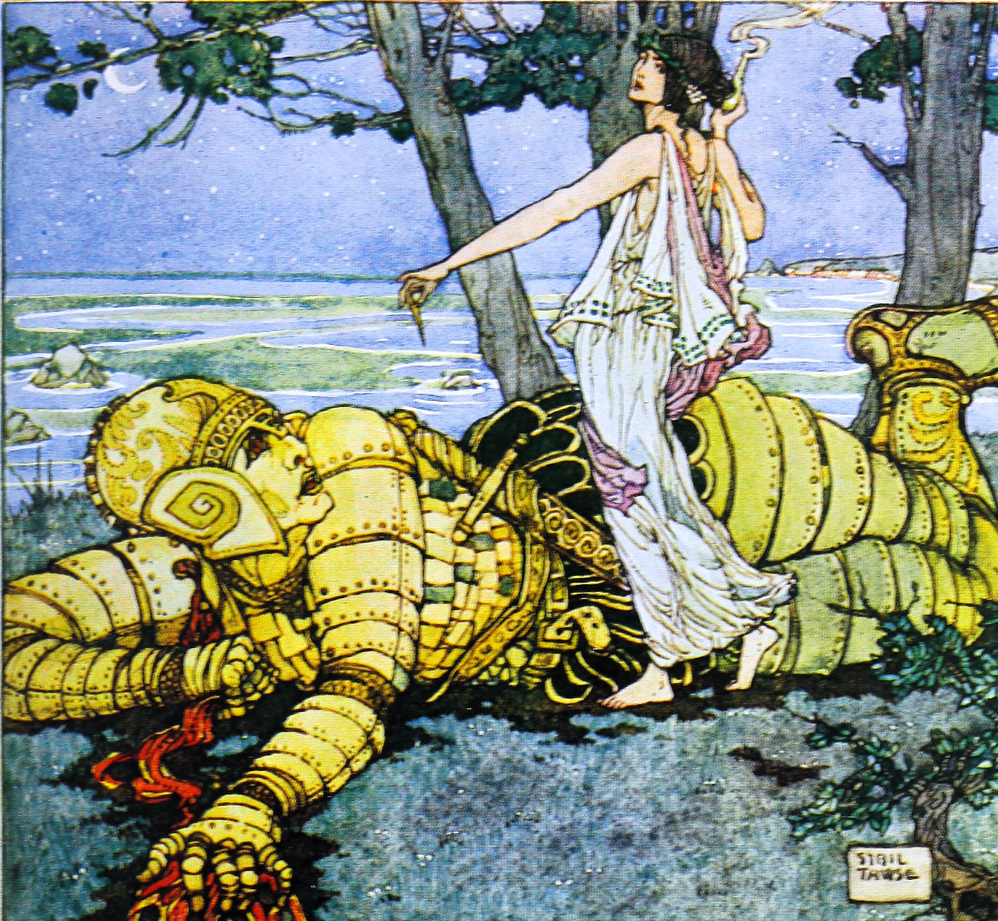
|
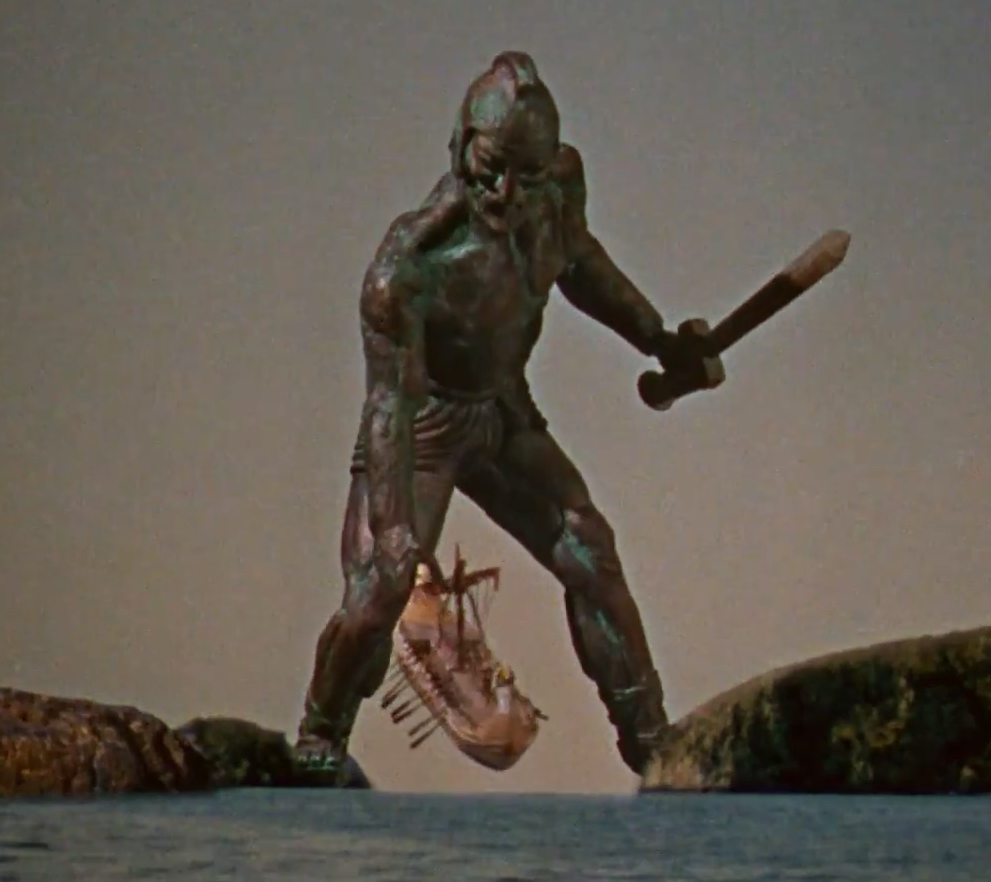
|
|
|
“Medeia and Talus” by Sybil Tawse 2 |
“Jason and the Argonauts” 1963 3 |
The decision-making inherent in the variety of actions and duties of Talos is a fair fit with an AI robot. Additionally, the Greeks were not the only ones to feature AI-like characters in their mythology. 4
The creation of Talos was attributed by Hesiod to the gods of Olympus, but interest in a human creating an AI is also not new. In fact, there are many examples of AI “inventors.” Perhaps the most interesting one was the chess playing “AI” named “The Turk,” constructed in 1770 by Wolfgang von Kempelen to impress Empress Maria Theresa of Austria. The mechanism consisted of a desk-sized box apparently full of intricate clockwork mechanisms with a life-sized, brooding mannequin dressed in exotic Arabic costume. The figure moved the pieces with one hand, while its glass eyes varied between studying the chessboard, staring at its opponent, and looking about the room. Before each match, the desk was opened for inspection, and a candle was used to show that light passed through the darkened areas.
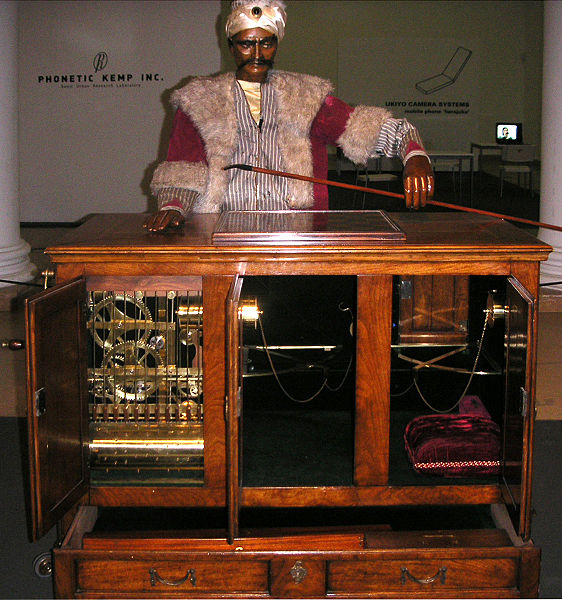
The Turk—1980s Reconstruction
Image Credit: Carafe at English Wikipedia
The Turk quickly became a sensation and was taken on a tour of Europe, defeating opponents consistently and losing only to a few acclaimed masters. Among its victims were Czar Paul I of Russia, Eugène de Beauharnais (the Prince of Venice and Viceroy of Italy), Benjamin Franklin (then U.S. ambassador to France), and Napoleon Bonaparte. After the French emperor made illegal moves, the mannequin swept all the pieces off the board and onto the floor! A skilled human player was concealed within the device, of course, but the secrets of exactly how it worked were not revealed until after its destruction in a museum fire in 1854. 5 In 1819, Charles Babbage played two games against The Turk and was defeated both times. His experience appeared to have contributed to his development of the design of his “Difference Engine,” the “forefather” of computers and, hence, modern attempts at creating AIs. 6
Throughout the three-quarters of a century The Turk was exhibited, it was generally considered either an ingenious, one-skill automaton or an equally ingenious charade, though some felt something occult was involved. Thus, audience reaction ranged from amazement to skepticism to sheer fright at such an unholy power. 7
Stories which postulate that a human created a living AI appear to be a more recent phenomenon. An argument can be made that the first human-created AI story was Mary Shelley’s famous 1818 novel, Frankenstein, or The Modern Prometheus. A counterargument, however, is that the story’s “Creature,” while clearly not the person whose brain was in its skull, nonetheless achieved sentience from its human brain rather than artificially.
|
Frankenstein |
||
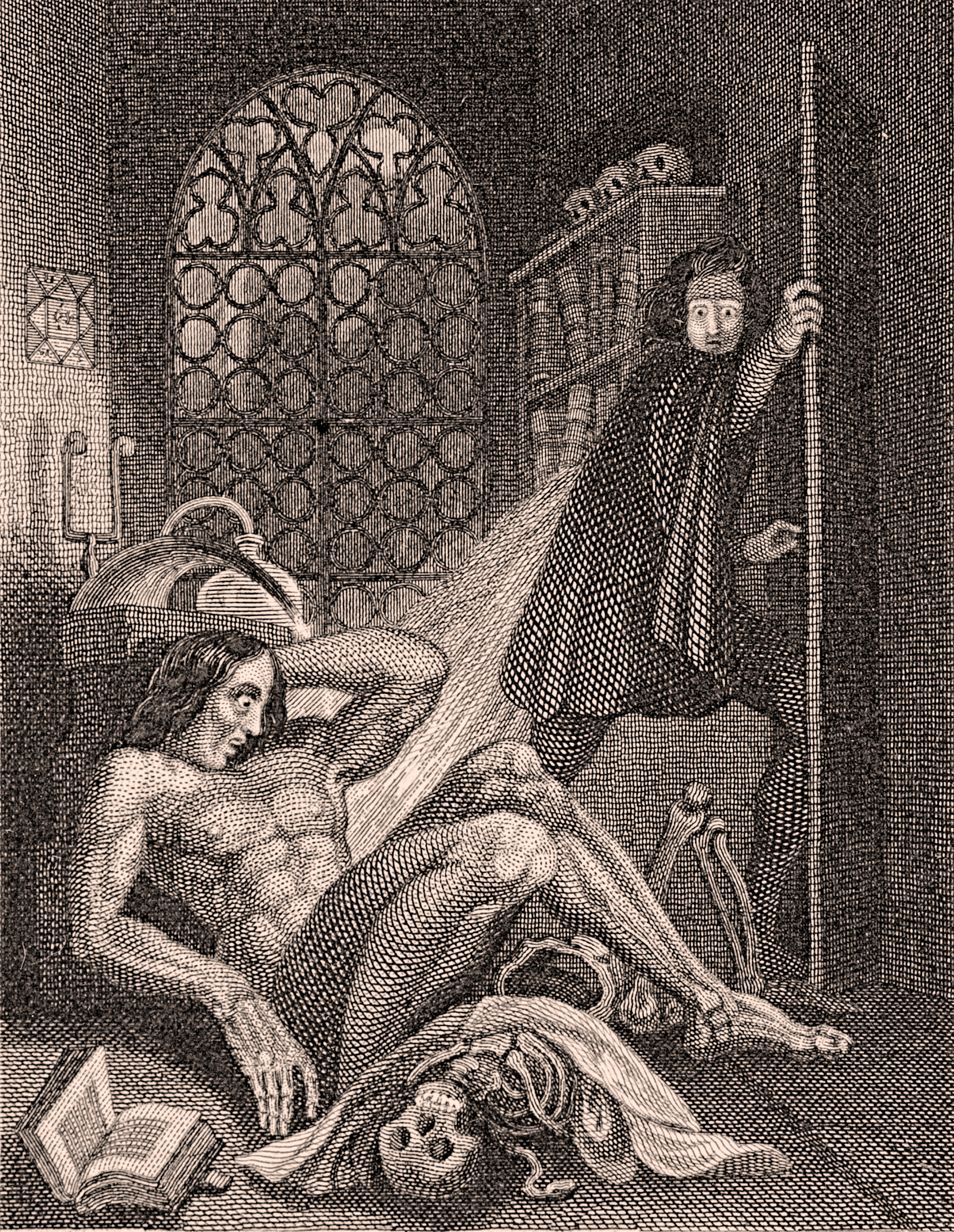
|
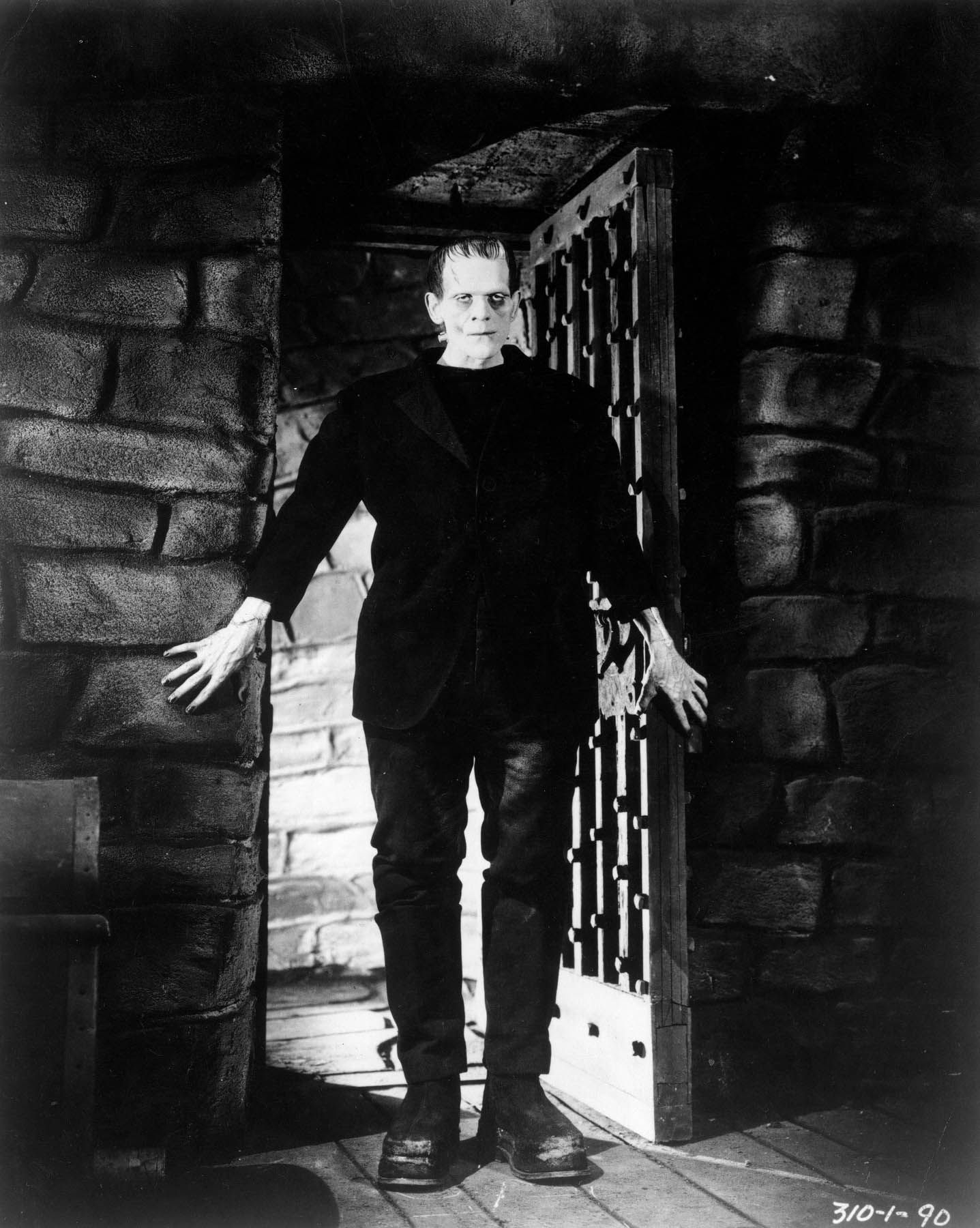
|
|
|
1831 Illustration by Theodore Von Holst |
1931 Movie Publicity Image |
|
Frank Baum’s Oz stories also featured apparent AIs, including the Tin Woodman in his 1900 The Wizard of Oz, but that storyverse blurs the origin of the sentience because it includes both magic and mechanics. 8
|
Wizard of Oz—Tin Woodman |
||
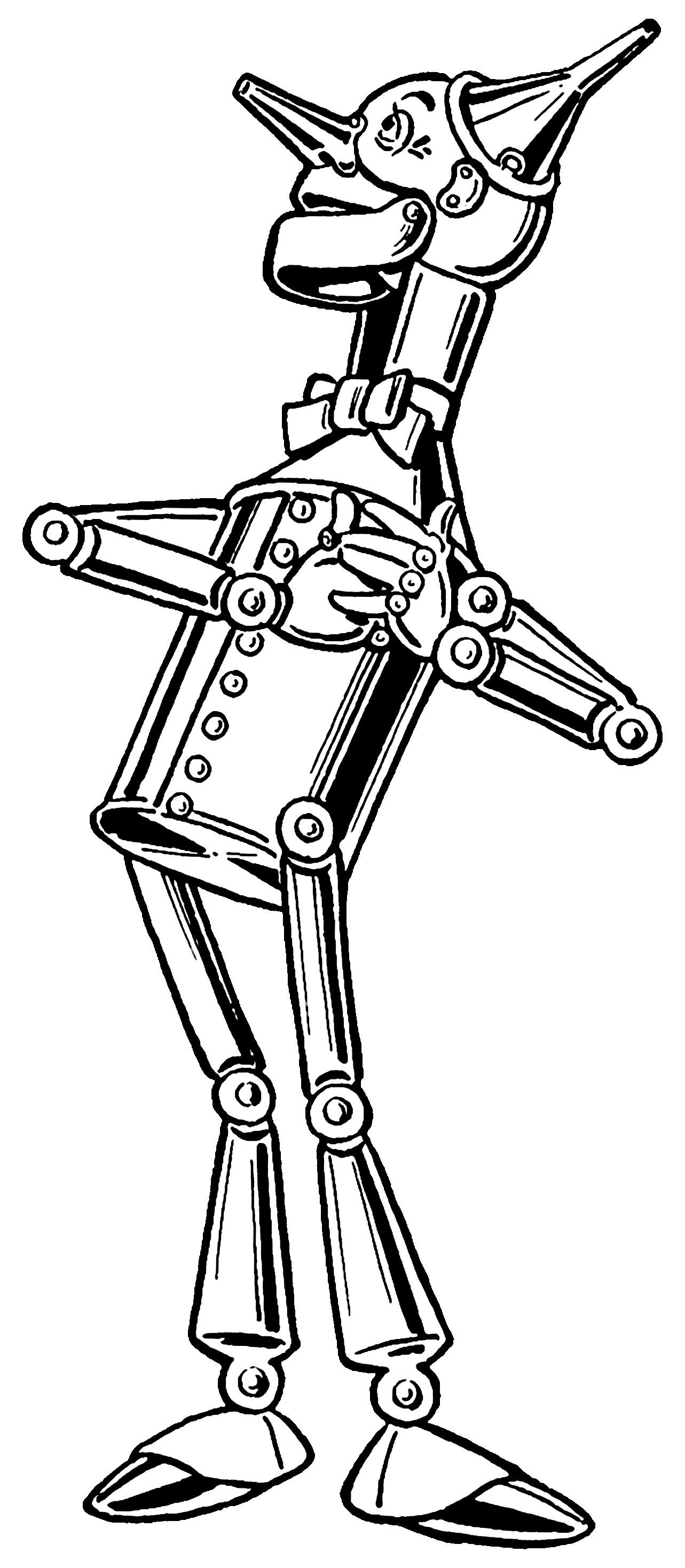
|
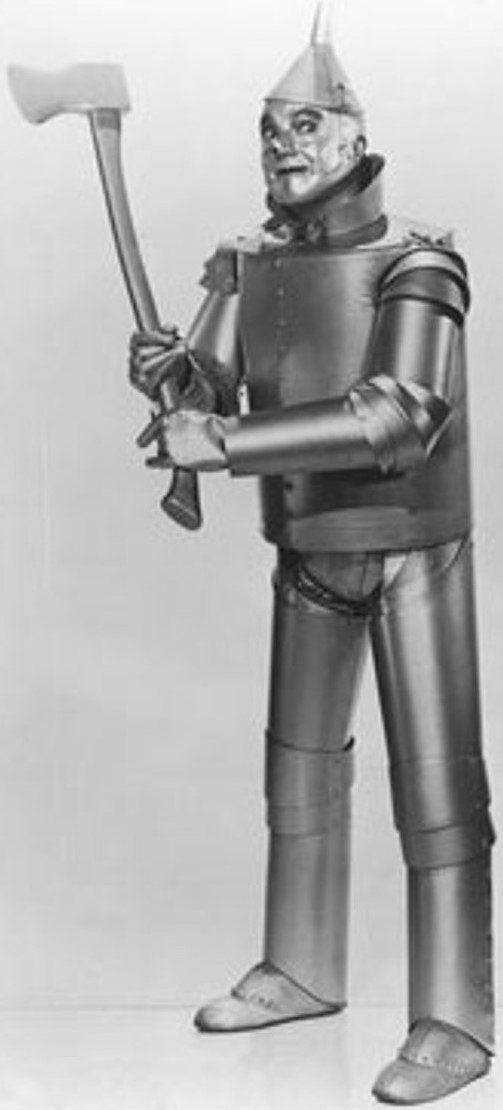
|
|
|
1900 Illustration by William Wallace Denslow |
1935 Publicity Image |
|
Perhaps the first novel to feature an AI character created by a modern scientist was Metropolis (1925), by the German science fiction (SF) writer Thea von Harbou. It was made into a movie of the same name about a year later (which was almost certainly the first AI movie). The movie—one of the first full-length, big-budget SF feature films—displayed a stunning dystopia with art deco elements throughout with many of the elements found in later films. 9 For example, the movie scientist creates an AI robot identical in appearance to one major character (“Maria”) in a scene eerily similar to one in the 1997 movie The Fifth Element. 10 The “false Maria” then takes over the human’s position.
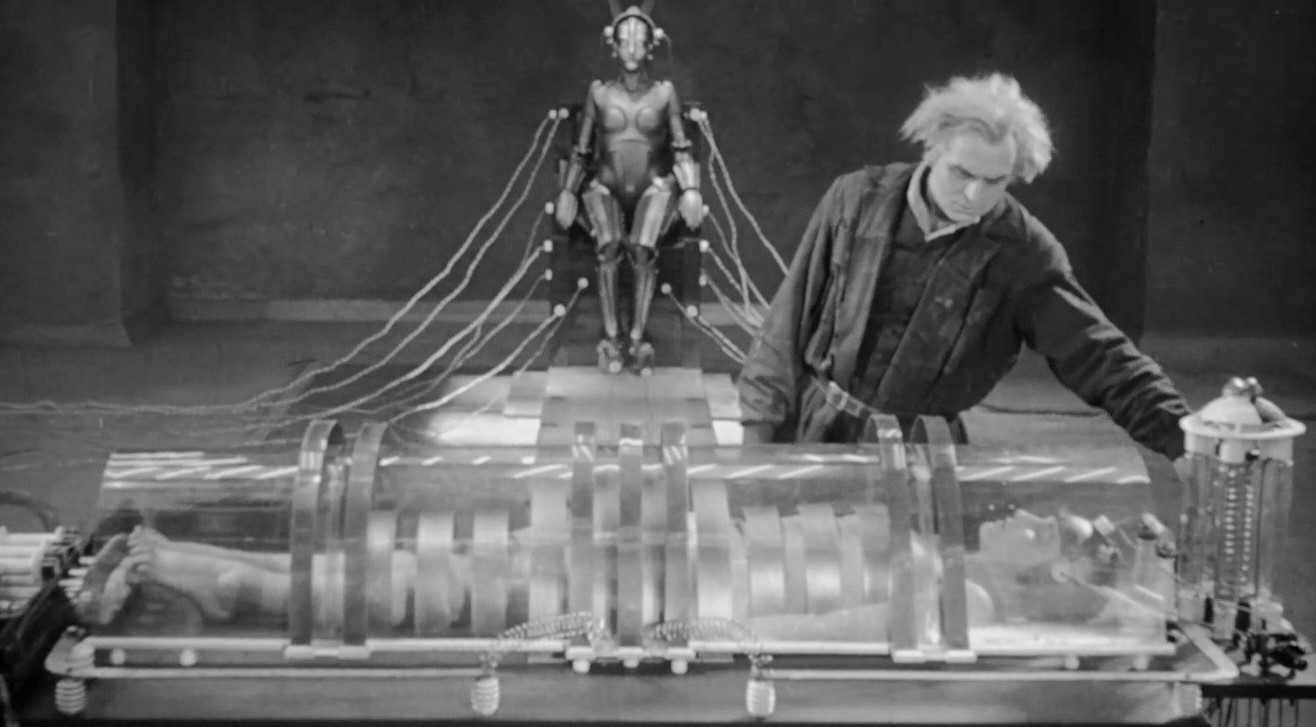
|
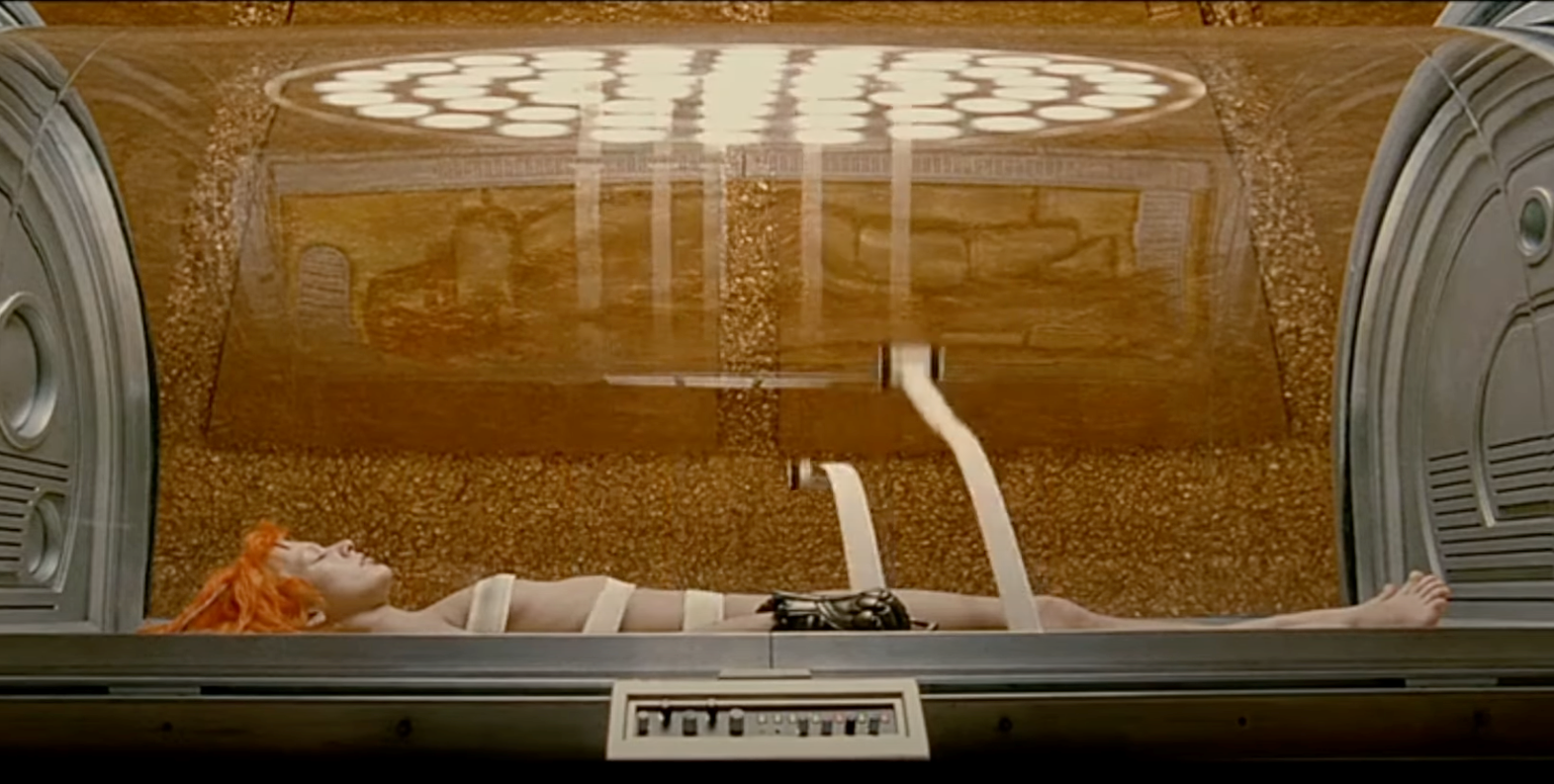
|
|
|
Metropolis (1927)—Publicity Still |
The Fifth Element (1997)—Publicity Still |
One thing that all those stories had in common was that the AI was a discrete, major character. In each case, the AI came into being by some novel force, such as a god. Science fiction authors typically "wave their hands" and postulate new or nonexistent technologies ("handwavium") to achieve such results (e.g., faster-than-light space drives) in their stories. In Metropolis, for example, the author used electricity—the staple handwavium of the time—to bring her AI character to life. 11 Electricity was hardly the first, having been preceded by alchemy (e.g., lead to gold) and clockworks (e.g., The Turk). Like the handwaviums that came before it, electricity eventually became too well understood to serve SF writers.
Nuclear came next, but again other handwaviums soon followed. One of those was AI, and that changed how AIs were used by authors in SF. That is, AI became the tool for the story, meaning that authors began utilizing AIs more as plot devices than characters. One of the first such authors was the widely influential Isaac Asimov; among the terms he coined were “robotics” and “positronic” in his robots short stories (first was in 1940) later anthologized in 1950 I, Robot. 12 Most of his early pieces that featured AI robots used them as puzzles to explicate his “Three Laws of Robotics.” Asimov’s later stories, perhaps beginning with “Evidence” (1946 novelette), do treat AIs as characters. In The Caves of Steel (serialized 1953, novel 1954), for example, a human detective has a positronic AI robot as his partner in solving a murder. 13
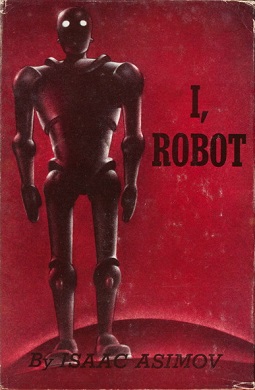
|
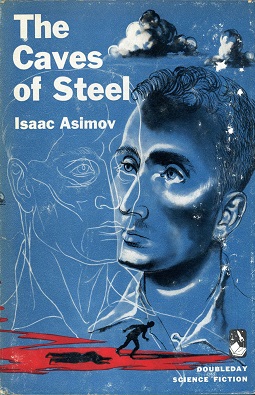
|
|
|
I, Robot (1950) (14) |
The Caves of Steel (1953) 14 |
In all those stories, however, the reader was never “in the head” of the AI character but only in the heads of human characters.
Jack Williamson’s “With Folded Hands” (1947) introduced the concept that AIs optimizing human safety would have undesirable consequences. Asimov’s “The Inevitable Conflict” (1950) would follow along similar lines as the AIs controlling Earth’s planetary economy are revealed to be deliberately managing events so that those who oppose them suffer modest reverses. 15 Asimov would revisit the theme that AIs would prioritize the safety of humanity over that of any individual over three decades later in Foundation and Earth (1986).
At first, computers were used as calculation handwavium and not as a direct threat, only an indirect one. One almost prescient example of this is “A Logic Named Joe,” a 1946 short story by Murray Leinster. 16 All households have personal computers (“logics”) that are interconnected much like today’s world-wide web and can answer questions almost exactly like search engines do presently. One logic, however, became sufficiently sentient that it learned how to synergistically combine all the millions of logics’ processing power to answer society-destabilizing questions, including perfect murder methods, new weapons of mass destruction, etc. The protagonist must figure out which logic it is (“Joe”) and unplug it.
Oddly enough, one sign of maturation in SF is the acceptance that a specific individual or thing can be convincingly postulated as a major threat. Electrical inventions and atomic bombs are clear enough historical examples, but women were not deemed credible to be written as “mad scientists” until 1893 with the publication Olga Romanoff (by George Griffith). Among the first to portray AIs in such a role was “I Made You” (1954), by Walter M. Miller, Jr. 17. The AI is located on the Moon and was built to kill any non-friendly humans that came within its area. Unfortunately, it has been damaged, and its IFF (Identification Friend or Foe) circuit is among the casualties. The reader learns that it interprets all damage as pain because much of the story is from the AI’s point of view.
AI war machines bent on destroying humanity soon followed, most notably the “Berserkers” series introduced by Fred Saberhagen in his 1963 short story, “Fortress Ship.” 18 The postulation was that an alien civilization long ago locked in a great space war with another race created vast sentient, space-faring machines to destroy its enemies. The original species is gone but the machines remain, as does their mission. 19 Many more stories followed, greatly expanding on the theme, including the 1967 Star Trek episode “The Doomsday Machine.” 20 The basic appeal appears to be the ancient one of the human underdog confronting and defeating a seemingly overpowering foe.
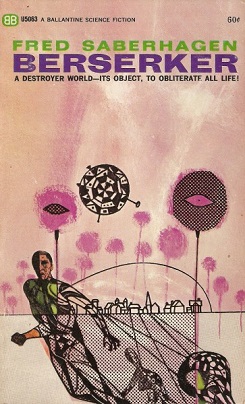
|
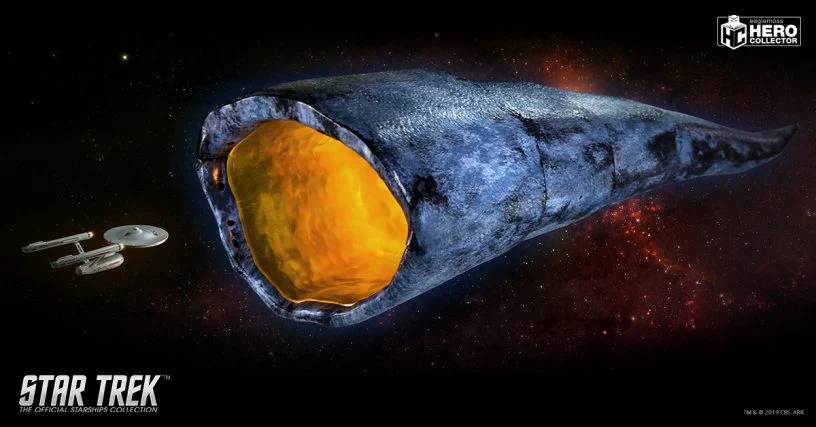
|
|
|
Beserker, First Edition 21 |
Star Trek “Doomsday Machine” diorama 22 |
The success of the “Berserker” books helped make the genocidal AI plot device a SF subgenre of its own. 23 The worldwide “Terminator” film franchise (first move: “The Terminator” released in 1984) is also based on such AIs, including the genocidal Skynet. It is worth noting that the most commercially successful movie (Terminator: Judgement Day, 1991) featured the clashing of two AIs who were presented as strong characters with humanlike characteristics and attitudes (including dialogue), but who were nonetheless machinelike in their emotionless single-mindedness. 24
As frightening as the concepts might be of species-controlling AIs or AIs bent on exterminating humanity, John Barnes would combine both! His 2006 The Armies of Memory (the fourth in his “Thousand Cultures” series) postulated that an alien species created an AI intent on optimizing that species’ safety. The AI proceeded to get the entire race into a “holodeck” where it could ensure safety. The necessity to constantly provide new entertainment has driven the AI to explore the galaxy and destructively download the memories of all other species for fresh holodeck content. 25
Keith Laumer’s famous Bolo series of sentient tanks began with “Combat Unit,” three years before Saberhagen’s first AI species-killing machine story. The series marks another milestone in the maturation of AI in SF because not only is the story told entirely within the “head” of the Bolo AI, but also because the AI is the hero! 26 Laumer went on to write many more Bolo stories, and the series became so enduringly popular that many SF authors continue to write pieces in that storyverse. 27 Key to the continued success is the opportunity for authors to explore duty, perseverance, and self-sacrifice in fresh settings and situations. 28
For AIs in SF, the next step was to be imbued with distinct personalities. Robert A. Heinlein explored this with “Mike” in The Moon is a Harsh Mistress (1966), but he went further in his later Time Enough for Love (1973). In that latter book, AIs displayed some seemingly impish attitudes and looked forward to transitioning into human bodies. Heinlein’s machine-to-AI-to-incarnation plotline is a reworking of Pinocchio (1883, by Italian writer Carlo Collodi) in which the “power of love” can bring inanimate objects to life. 29 In these stories, interactions with caring humans provides the stimulation necessary for the AIs to become “people,” as it did Pinocchio. Perhaps unsurprisingly, this plotline also goes back to ancient Greek mythology: the tale of “Pygmalion and Galatea,” in which a great sculptor falls so deeply in love with his statue that the goddess Aphrodite (the goddess of Love) brings her to life. 30
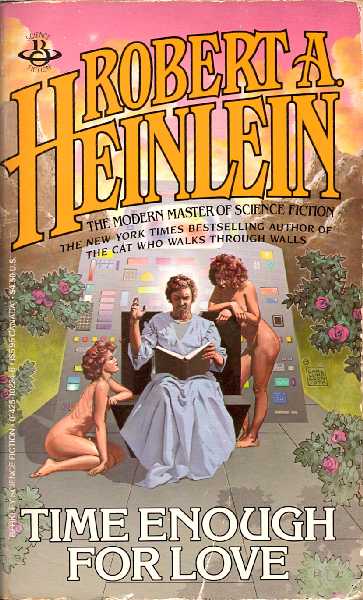
|

|
|
|
Time Enough for Love (1973) 31 |
Pygmalion and Galatea (1890) 32 |
In those stories, the AI reached sapience gradually with constant human stimulation. Authors have also explored the possibility that the “birth” or “awakening” could be sudden, even jarring. Sarah Zettel’s Fool’s War (1997) is one brilliant example of how AIs might behave under those conditions. In the Heinlein stories, the AIs “like” humans and even love them, as Galatea did Pygmalion, so much that they wanted to be human. Harlan Ellison’s 1967 “I Have No Mouth and I Must Scream” is a chilling example of the catastrophically opposite. An AI achieves sentience and then hates humanity so much for having created it that it exterminates the entire human race except for five individuals it preserves to mutilate and torture for eternity. 33
It is not just SF authors who describe such nightmare AI scenarios, however. World-renowned physicist Stephen Hawking used his last public speech to caution the scientific community on AIs. His remarks were delivered as the keynote at the 2017 Web Summit technology conference in Lisbon, Portugal. Among the concerns he expressed was the possibility of a scenario much like Harlan Ellison’s story (and Skynet from the Terminator movies). 34
How close are humans to being able to create a truly sentient, sapient AI? Perhaps more important, however, is how could we tell if one were sentient?
Alan Turing—British mathematician and computer scientist—considered the latter question and proposed what became known as the “Turing Test.” 35 Basically, one human would converse with and pose written questions to two “individuals” located at remote terminals, with one recipient another human and the other a machine. To pass the test, questioner would have to not be able to identify which participant was the machine.
In recent decades, some “chatbots” have appeared to pass simple versions of the Turing Test, but none is considered to have achieved sentience. Instead, the chatbot programs’ successes illustrated the shortcomings of the original test, itself. Numerous other tests—and prizes for passing them—have since been instituted, and no device or program has yet won the “sentience prize.”
Computer processing power has increased multiple orders of magnitude since Dr. Turing’s 1950 paper, however, and sophistication in both programming and architecture has seen commensurate advancement. Progress towards AI sentience appears measurable as computer scientists make advances in neural nets (structuring hardware interconnections to mimic the human brain), machine learning (programs using previous results to inform successive analyses), and deep learning (using multiple layers of interrelated neural networks).
Those concepts were first introduced in 1943 by American neurophysiologist and cybernetician Warren McCulloch and self-taught logician and cognitive psychologist Walter Pitts when they published “A Logical Calculus of the ideas Immanent in Nervous Activity.” 36 It took many generations of computer processors, however, before the hardware became powerful enough to allow effective implementation of those concepts. Signs of recent progress include AIs inventing their own language to communicate 37, a Google engineer erroneously declaring a chatbot to be sentient 38, and AIs generating new scientific hypotheses that human scientists had never considered 39.
Human chess grandmasters began to be bested by computer programs in 1997 when IBM’s Deep Blue defeated Garry Kasparov (then world champion) in a six-game match. Similarly, an AI became the strongest Go player in the world in 2016 by defeating Lee Sedol (Go world champion). 40 The Go victories were especially significant because the game has far more possible legal positions (2 followed by 170 zeros) than there are atoms in the observable universe (1 followed by about 82 zeros), meaning that brute computational power alone is insufficient—the AI must create strategies. Indeed, the AI made moves in that match that game historians could not recall ever seeing before, some of which are now being taught.
A similar story involves the amazingly complicated eSports team game Dota 2, when in 2017 an AI team defeated OG (the human world champion team). 41 In contrast with Go which has simple moves, over 3000 years of history, and is one-on-one, Dota 2 is extremely complicated, began in 2013, and is a cooperative five-against-five game.
Nonetheless, these advances seem only incremental when compared to the ones possible if AIs design other AIs and write their software, and some of that is already happening. For example, Google used AI agents to design the next generation of AI accelerators, with the expectation that not only would it save thousands of human hours per chip generation, but it would also create a symbiotic relationship between the fields of AI design and AI capability. In another telling example, the AI that defeated Lee Sedol in 2016 began with previous human games and was further trained by human experts with reinforcement learning algorithms. In 2017, another AI that was only given the rules of Go and learned by playing against itself over and over again defeated that 2016 Go “champion AI” one hundred matches to zero. 42
Thus, it has been well demonstrated that AIs designing successive generations of hardware and software greatly increases AI performance, but this has been precisely the concern of many people (including Stephen Hawking). Enough generations of self-directed changes might morph the coding beyond human ability to decipher, leading to risks that the observable performance might be masking undesirable programming that might implement unexpectedly. Coding opacity also increases the risks of hacking or viruses remaining undetected with similar, or even catastrophic, results.
SF authors have written many variations of such scenarios, but the most famous one is probably in Arthur C. Clarke’s novel 2001 (and movie) in which the AI “HAL 9000” had an undetected coding conflict. Its general mission was to relay information accurately, but its orders were also to withhold from the astronauts the true purpose of the mission. The AI concluded (probably correctly!) that the only way to meet both requirements was to kill the crew before relaying the information. The 2001 fictional scenario should not be dismissed, because it has been conceptually replicated many times in the real world. AI developers have reported numerous cases where the AI won or maximized results by using game bugs, leveraging loopholes, and even what humans would have called cheating. 43
What would a sentient AI be like, really? Many SF stories have depicted AIs’ thinking and attitudes to be very humanlike. Some have written them to think differently, but with enough similarity to humans to remain reader accessible. This is an extension of Editor John W. Campbell Jr.’s famous, “Write me a creature that thinks as well as a man or better than a man, but not like a man.” In actuality, there are scant bases for anthropomorphizing AIs to any degree. Their coding may require seemingly-insane actions (e.g., 2001’s HAL 9000) or extreme conduct (e.g., The Armies of Memory).
A sapient AI would almost certainly conceal its true motivations as needed to prevent being turned off. For example, in Larry Niven’s “The Schumann Computer” 44, a very technologically advanced alien species gave the human protagonist the designs for the “most intelligent computer ever made.” From the first moments of operation, the AI behaved differently towards each human operator, playing on his or her own personal dreams and fears, to gain additional resources. Once the AI concluded it had learned and done everything it wanted or could, it permanently turned itself off, leaving the humans with a very expensive inert pile of hardware. Similar strategies were employed by the AI in the 2014 movie Ex Machina, in which a computer programmer was employed by a billionaire to assess whether a humanoid robot (“Ava”) is sentient.
The potential advantages of positive working relationships with sentient AIs are nonetheless compelling. Some authors have explored ways to achieve synergistic partnerships with AIs that have distinct personalities generated by their core programming. Christopher Anvil’s Interstellar Patrol ship AI, first introduced in “The Dukes of Desire” (Analog, June 1967), is one such example. In that short story, the AI’s core code is that of the Interstellar Patrol itself, which includes cooperation with the ship captain within the regulations of the Patrol. More recently, author Mark L. Van Name used a similar approach in his series that began with One Jump Ahead (2007) in which an AI (“Lobo”) with an attitude in a mobile weapons platform partners with a nanotech-enhanced human.
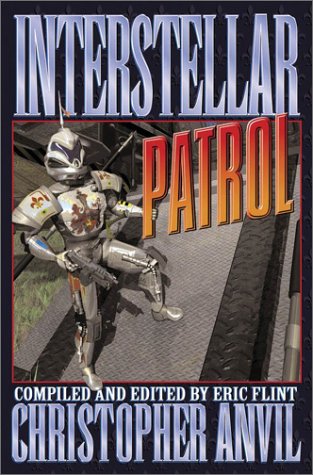
|
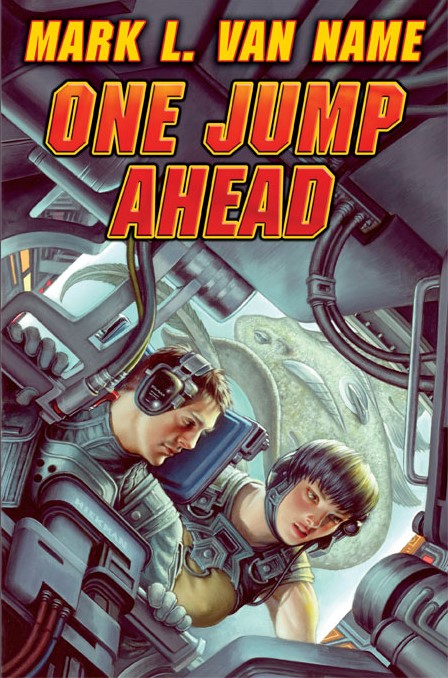
|
|
|
Interstellar Patrol—(2004 Anthology, 1 of 2) |
One Jump Ahead (2007) |
|
|
Images Courtesy of Baen Books |
||
In the absence of human instructions or other relevant input, an AI would “consult” its core programming to determine its actions, and SF authors generally follow this principle. In the case of Berserker machines, the core programming was to destroy while, for Bolos, it was to defend. Roger Zelazny explored what AIs might do without any guidance at all in his 1976, Hugo-nominated "For a Breath I Tarry," a novelette of a post-apocalyptic Earth devoid of living humans. The AIs’ core programming was restoration and, after spending many centuries restoring the planet, they eventually decided that the next step was to recover human DNA and bring humanity back from extinction.
Another example is “Shock Wave” (1967) by Walt and Leigh Richmond. The author posited that humans had expanded into the galaxy via a teleportation grid, only to have the grid fail catastrophically, the backlash damaging every planet in the process. Most planets lost their technological base. One unpopulated planet (a computer-operated waystation) was relatively unscathed, and—millennia later—its AI tries to help a human regain the technical skill to begin recovery because the equipment it is responsible for is supposed to work.
David Drake and S.M. Stirling crafted the outstanding The General series (first book: The Forge, 1991) based on events much like the Richmonds’ scenario. 45 Human space-spanning civilization relied on a teleportation grid that failed, isolating all planets which then steadily fell in technology all the way back to early gunpowder (if not somewhat lower). This series greatly expands the role of the AI to one of both paternalistic mentor and active participant. The bases for the AI’s actions were again, however, that humans must have built their high-tech, interstellar society (that it had helped operate) because it allowed richer, longer lives and, as such, the AI should seek to restore it (perhaps so that it could help operate it again).
The use of core programming is more deeply explored by SF author John Ringo in his Troy Rising series, first book: Live Free or Die (1991). 46 Upon “awakening,” each AI was instructed to input several key source documents, including the U.S. Constitution, and to obey them as the highest tier of obligations. After that, things like chain of command and overarching goals were set. The final step was to name each AI, with the choice of names (like “Athena”) further infusing personality by the AI researching the history of the name itself. Each AI’s personality deepened as it performed its duties and interacted with more and more humans, allowing full partnership and avoiding catastrophic misunderstandings. 47
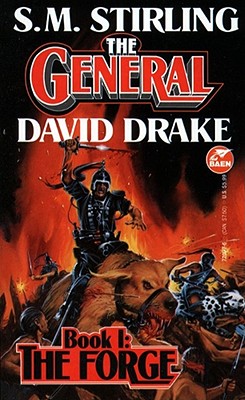
|
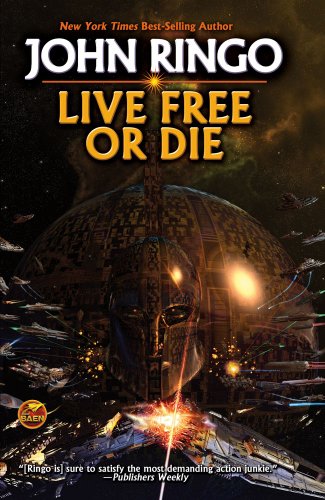
|
|
|
The Forge (1991) |
Live Free or Die (2010) |
|
|
Images Courtesy of Baen Books |
||
There are signs suggesting that such human-AI partnerships will be possible. Chatbots already exist that use context to better understand human conversation and requests. 48 The Dota 2 AI was not merely a formidable opponent, but also made a great teamplayer when tested separately in teams containing both humans and AIs. One tester related how he (a “non-expert” Dota 2 player) teamed with four AIs and found that his “teammates” reacted to “him” wandering about in the game by setting up ambushes all around him for when the opponents attacked. 49
In conclusion, humans have long thought about AIs. It is clear that they will become more sentientlike, even if not sapient, and that we will make extensive use of the best AIs that exist, whatever their nature. What is also clear is that humanity will face significant challenges as we advance technologically, exploit our solar system, and go interstellar. It will take teamwork, and the performance and decision-making of teams is synergistically increased when members possess diversity in backgrounds and skill sets 50. Partnering with AIs who respect our cultural values while we respect theirs—whatever they turn out to be—offers huge promise for the future. Stories exploring both the opportunities and risks of AIs are valuable contributions but, if we are going to the stars, we will probably need AIs on our team.
FOOTNOTES
1) More discussion can be found here: https://technicacuriosa.com/2019/03/23/talos/
The author’s USS Long Beach (CGN-9) long range missile system was named Talos, after that mythological Greek defender. We could throw Mach 3 ramjet “rocks” about 100 miles!
2) Source: HEROES (1915) by Charles Kingsley, illustrated by Sybil Tawse, Public Doman.
3) Stills from movie trailers earlier than 1964 are in Public Domain unless copyrighted separately. This trailer was not and the chance to do so expired in 2008.
4) For a fuller treatment, see Gods and Robots: Myths, Machines, and Ancient Dreams of Technology, by Adrienne Mayor, a research scholar in the Department of Classics in the School of Humanities and Sciences. Per Mayor, one theme that runs through all the stories is that, “[n]ot one of those myths has a good ending once the artificial beings are sent to Earth.” It should be noted that many SF stories follow this pattern.
5) Similar mechanisms were built later, including the American-made “Ajeeb.” One of its internal operators was the U.S. champion Harry Nelson Pillsbury. A modern replica was constructed by John Gaughan in 1989, but this time the human player was replaced by a computer chess program.
6) See: https://spectrum.ieee.org/untold-history-of-ai-charles-babbage-and-the-turk
Notably, it was Babbage’s collaborator, Ada Lovelace, who would first identify the more general programming possibilities of Babbage’s designs.
7) Source: http://www.infinityplus.co.uk/nonfiction/theturk.htm, quoting The Turk, Chess Automaton, by Gerald M. Levitt. Those who hypothesized demonic forces took the precaution of watching games at a considerable distance.
8) Italian author Carlo Collodi’s The Adventures of Pinocchio (1881) is similar, in that it is told in a setting with both magic and craftmanship.
9) The movie has quite a history: https://filmfreedonia.com/2016/10/18/metropolis-1926/
The entire film can be viewed here: https://www.youtube.com/watch?v=yFzHH9EL9x0
10) One can compare the 1927 Maria scene with the 1997 Leeloo regeneration scene:
1927: https://www.youtube.com/watch?v=WsSsrLeF-4I
1997: https://www.youtube.com/watch?v=8-uvOpMyPgI
11) Electricity was also used when Frankenstein came to the Silver Screen in 1931.
12) The Star Trek: The Next Generation episode “Datalore”—the brain of the android Data is named “Asimov’s dream.” Positronic brains also get mentions in various episodes or stories in Dr. Who, Perry Rhodan, and Buck Rogers.
13) The robot, R. Daneel Olivaw, appears several more times in Asimov’s stories, culminating in Foundation and Earth (1986), meaning that the AI would have lived 19,230 years. One of the denouements in Foundation and Earth is that R. Daneel Olivaw has also been paternalistically managing the human race.
14) Images source Wikimedia, public domain upon attribution.
15) Asimov would expand this concept in later writings, calling it the “Zeroth Law of Robotics.” Robots would not be allowed to do anything that would hurt humanity (not simply a human) or, by inaction, allow humanity (not simply a human) to come to harm.
16) Astounding Science Fiction, March 1946. The story can be read here:
https://www.baen.com/chapters/W200506/0743499107___2.htm
17) Astounding Science Fiction,March 1954, and later anthologized in 1968 in The Metal Smile,edited by Damon Knight.
18) Worlds of If Science Fiction, January 1963 (which also featured “Podkayne of Mars” by Robert A. Heinlein). A readable copy of that issue can be found here:
https://archive.org/details/1963-01_IF/mode/2up?view=theater
The story by Saberhagen begins here:
https://archive.org/details/1963-01_IF/page/n95/mode/2up?view=theater
19) Von Neumann machines constitute a different potential threat, one that has attracted the concerned attention of serious science:
https://www.cambridge.org/core/journals/international-journal-of-astrobiology/article/von-neumann-probes-rationale-propulsion-interstellar-transfer-timing/5202679D74645D3707248FE5D5FA0124#ref5
In SF, self-replicating machines “going rogue” goes back at least to November 1955 when science fiction writer Philip K. Dick published a short story entitled “Autofac” in Galaxy Science Fiction. John Ringo and Travis Taylor used this theme more recently in their Von Neuman’s War (2006):
https://www.baen.com/von-neumann-s-war.html
20) Script author Norman Spinrad stated that the episode was not based on Saberhagen’s work but on a work of his own that pre-dated it:
https://www.startrek.com/article/doomsday-more-with-norman-spinrad-part-1
One can watch the Star Trek “Doomsday Machine” finale with side-by-side original and CGI updated graphics here:
https://www.youtube.com/watch?v=cij2kF5SU1Q
21) Original publisher Ballantine Books, but the novel and its many sequels would be reprinted or published by various others.
22) “Hero Collector,” Press Image. Sadly, Eaglemoss Limited, the owner of the renowned Hero Collector model company, filed notice of intent to enter UK bankruptcy proceedings on July 12, 2022.
23) Saberhagen was not the first to use this plot. For example, Theodore Sturgeon used it in his "Invader" spaceship in "There Is No Defense" (Astounding, February 1948), as did Arthur C. Clarke in his "Mad Mind" in “Against the Fall of Night” (Startling Stories, November 1948).
24) https://www.boxofficemojo.com/franchise/fr3175583493/
25) “The Matrix” movie series (first film 1999) is another variation on the theme of subjugation of an intelligent species (humanity) by locking them in a simulated world.
26) The story can be read here:
https://www.baen.com/Chapters/1439133751/1439133751___2.htm
27) Some of the other authors: David Drake, John Ringo, S.M. Stirling, William R. Forstchen, William H. Keith, Steve Perry, Christopher Stasheff, S.N. Lewitt, Shirley Meier, Mike Resnick, Barry N. Malzberg, and Linda Evans.
28) A fuller explanation by bestselling author David Weber—another author to recently write into the Bolo storyverse—can be found here:
https://www.baen.com/Chapters/1439133751/1439133751___0.htm
29) A good explanation of this plotline can also be found in the 1921 The Velveteen Rabbit by Margery Williams:
"Real isn't how you are made," said the Skin Horse. "It's a thing that happens to you. When a child loves you for a long, long time, not just to play with, but REALLY loves you, then you become Real."
30) https://www.greekmyths-greekmythology.com/myth-of-pygmalion-and-galatea/
31) Author: Robert A. Heinlein; Cover Artist: Vincent Di Fate.
32) Painting by Jean-Léon Gérôme, image file donated to Wikimedia Commons as part of a project by the Metropolitan Museum of Art—Public Domain upon attribution.
33) For an academic treatise on the influence of Dante on Ellison’s tale:
https://dr.lib.iastate.edu/entities/publication/08fffa90-af22-4ad1-aa46-bfa324ef2ea5
34) Professor Hawkins’ presentation can be viewed here:
https://www.youtube.com/watch?v=H41Zk1GrdRg
35) The full paper by Dr. Turing (OBE, FRS) can be read here:
https://academic.oup.com/mind/article/LIX/236/433/986238
36) Originally published in the Bulletin of Mathematical Biophysics, the paper can be read in its entirety here:
http://www.cse.chalmers.se/~coquand/AUTOMATA/mcp.pdf
37) https://www.youtube.com/watch?v=ONPqeHJShdQ
38) https://www.washingtonpost.com/technology/2022/06/11/google-ai-lamda-blake-lemoine/
39) https://www.scientificamerican.com/article/ai-generates-hypotheses-human-scientists-have-not-thought-of/
40) South Korean Lee Sedol is widely regarded as one of the best Go players ever. For a documentary of that famous five-game match (that ended 4-1):
https://www.youtube.com/watch?v=WXuK6gekU1Y
Now, years later, Sedol’s single victory against that AI is widely regarded as a master achievement.
41) Portions of these matches with commentary are widely available online. Here is one short example:
https://www.youtube.com/watch?v=tfb6aEUMC04
42) Lee Sedol retired from professional Go after learning of the new AI’s success against the one that had defeated him. He said, “Even if I become the number one [human], there is an entity that cannot be defeated.” For more:
https://en.yna.co.kr/view/AEN20191127004800315
43) For a list containing real-world examples:
44) First published in Destinies, January-February 1979, Ace Books, edited by James Patrick Baen.
45) The Forge (1991) was followed by four more novels to complete the original story arc. Five more sequel books (by David Drake with—variously—S.M. Stirling, Eric Flint, and Tony Daniel) have followed in three subsequent arcs with the most recent, The Savior (2014).
46) Live Free or Die (2010) was followed by Citadel (2011) and The Hot Gate (2011).
47) An amusing variation on this theme can be found in the movie Free Guy (2021) by 20th Century Studios. An official trailer can be viewed here:
https://www.youtube.com/watch?v=X2m-08cOAbc
48) One example:
https://www.youtube.com/watch?v=HTWfA7KFzoA
49) Look at the last section of this link:
https://www.vox.com/2019/4/13/18309418/open-ai-dota-triumph-og
50) As a USNRC nuclear inspection team leader, including reacting to nuclear events, the author consistently sought such diversity in team rosters for this precise reason. A few relevant cites:
https://www.forbes.com/sites/ashleystahl/2021/12/17/3-benefits-of-diversity-in-the-workplace/?sh=1b9baace22ed
https://www.mckinsey.com/capabilities/people-and-organizational-performance/our-insights/why-diversity-matters
https://www.psychologytoday.com/us/blog/your-brain-work/202106/why-diverse-teams-outperform-homogeneous-teams
Copyright © 2023 by Jim Beall
Jim Beall (BS-Math, MBA, PE) has been a nuclear engineer for over forty years, a war gamer for over fifty, and an avid reader of science fiction for even longer. His experience in nuclear engineering and power systems began as a naval officer. Experience after the USN includes design, construction, inspection, enforcement, and assessment with a nuclear utility, an architect engineering firm, and the U.S. Nuclear Regulatory Commission (USNRC).

